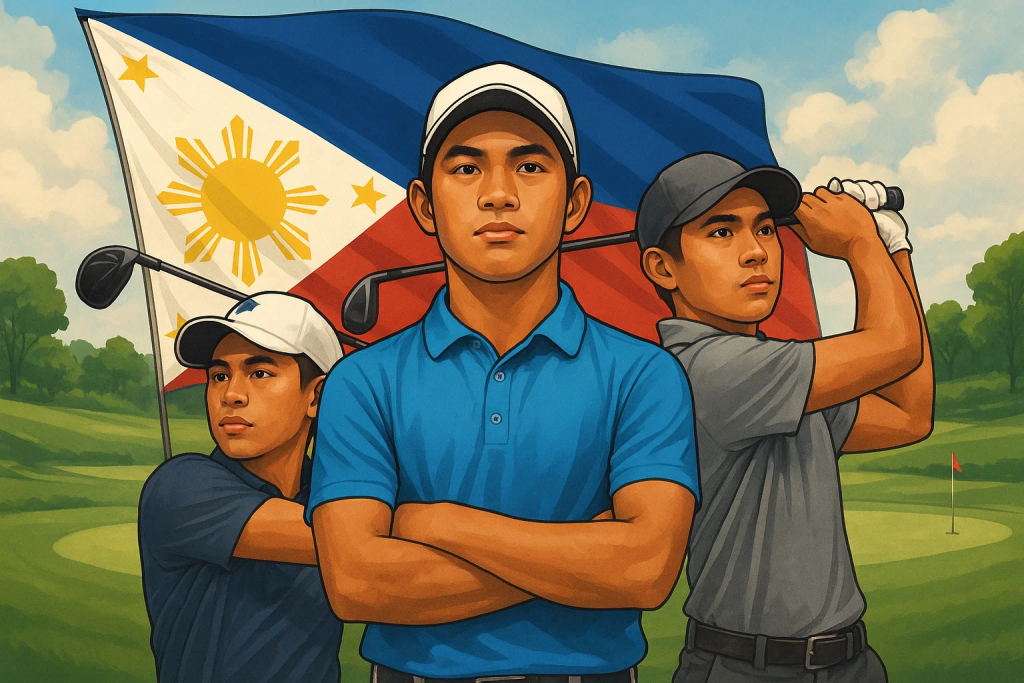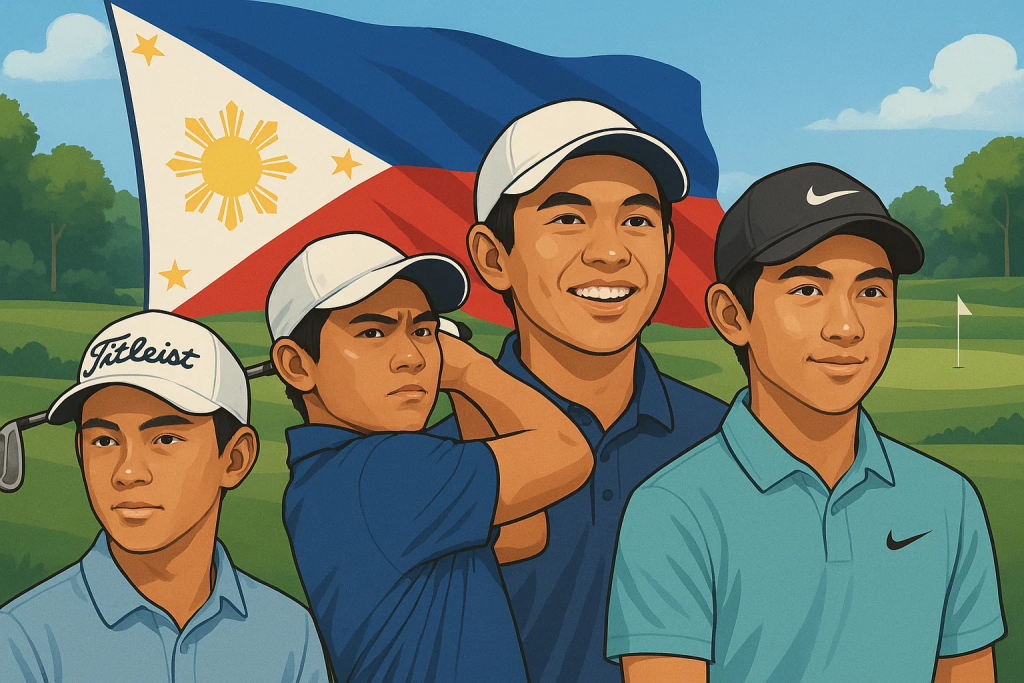Table of Contents
Executive summary
A decade ago, a Filipino flag on a PGA Tour leaderboard felt like a dream. Today it’s a regular sight—thanks in large part to Rico Hoey, the Manila-born pro who earned his PGA Tour card via the Korn Ferry Tour and now competes week-in, week-out under the Philippine flag. His ascent, combined with the international experience of peers like Justin De Los Santos (Japan Golf Tour), Miguel Tabuena (Asian Tour), and Lloyd Jefferson Go (global starts), signals a structural shift: the Philippines is building a repeatable pathway from junior golf to the sport’s biggest stages.

1) The headline story: A Filipino flag on the PGA Tour
Rico Hoey was born in Manila and grew up in California, starred at USC, and broke through with a Korn Ferry Tour victory in 2023 to clinch full PGA Tour status for 2024. In early 2025, he grabbed headlines by surging into contention at The American Express, underlining that his card wasn’t a one-off—he can contend against the world’s best. For Filipino golfers, coaches, and sponsors, Hoey is proof that the PGA Tour pathway works when talent meets structure, resilience, and the right schedule.
Why it matters: one player on the PGA Tour changes aspirations across an entire system. It lifts media coverage, unlocks sponsor belief, and encourages federations and schools to invest in junior-to-elite programs. It also puts a visual anchor on broadcasts: every time fans see the Philippine flag next to a player name, the sport’s addressable audience at home gets larger.
2) The next wave: who’s close, and why that matters
- Justin De Los Santos: A Philippine national who has carved a consistent career on the Japan Golf Tour, De Los Santos earned a start at The Open via the Mizuno Open and regularly competes in high-standard fields—a crucial proving ground for major qualification and world ranking points.
- Miguel Tabuena: Long the Philippines’ standard-bearer on the Asian Tour, Tabuena bagged the DGC Open in 2023 and keeps posting top-10s in International Series events and national opens. His presence stabilizes the performance baseline for the national program and provides mentorship gravity for younger pros.
- Lloyd Jefferson Go: A Cebu-born Seton Hall alum with global experience, Go’s profile across OWGR-tracked events and Asian circuits demonstrates another viable pathway for PH players who mix developmental tours, qualifiers, and co-sanctioned starts.
Together, this group—one already on the PGA Tour and several others competing in Tier-1 Asia/JP circuits—creates a “ladder of proximity.” Juniors can see the steps: national junior events → elite amateur → Asian/Japan tours → Korn Ferry → PGA Tour.
3) The systems view: how the PH pipeline is getting stronger
3.1 Federation & school structure
The National Golf Association of the Philippines (NGAP) has intensified junior calendars, regional activations, and national pools, with 2025 announcements spotlighting Junior Amateur championships, Mindanao/Visayas programs, and even support for UAAP inclusion—all of which broaden catchment and keep kids in the game through adolescence.
3.2 Tour adjacency and scheduling
The Philippines sits geographically and competitively in a sweet spot: top PH pros can chase starts on the Asian Tour, Japan Golf Tour, and co-sanctioned events that feed OWGR points and major berths. A small but smart calendar—peaking for qualifiers, International Series events, and national opens—maximizes upward mobility without overtravel.
3.3 Media & fan engagement
A visible Filipino on the PGA Tour changes highlight reels at home. When Hoey leads rounds or contends on Sunday, casual fans become appointment viewers, and brands see a straight line from broadcast to local retail. That attention lifts all boats—from junior tournaments to club memberships and grassroots clinics.
4) Skill DNA of the new Philippine pro
From interviews and performance patterns across Asian and US circuits, four repeatable strengths stand out:
- Ball-striking discipline: Many PH pros develop on tight, wind-kissed courses and grainy greens, building patient shot-by-shot discipline that travels.
- Short-game creativity: Grain and bermuda create chipping/putting demands that reward imagination and touch—skills that translate anywhere.
- Tournament resilience: A culture of playing through week-to-week variability (weather, travel, field strength) toughens decision-making.
- Adaptability: Switching between Asia, Japan, and US setups forces rapid course-mapping and pragmatic preparation.
Those traits don’t guarantee PGA Tour wins, but they lower the skill gap when PH pros step into big weeks in the US.

5) Case study: How Rico Hoey broke through (and what juniors can copy)
Milestones that matter
- Junior & collegiate platform: All-American pedigree at USC reinforced elite habits—daily practice standards, sports-science support, and tough competition.
- Korn Ferry Tour win → PGA Tour card: The 2023 Visit Knoxville Open victory unlocked status, scheduling choice, and confidence.
- Early PGA Tour spikes: Co-lead stints and low rounds in 2024–25 proved the skill ceiling is tour-contending, not just “card holder.”
What juniors can emulate
- Choose battlefields wisely: stack events that count (OWGR, qualifiers, developmental tours with promotion pathways).
- Treat adversity as a rep: Hoey’s mid-career resets—injury, form dips—became building blocks rather than detours.
- Own your flag: Switching representation to the Philippines (while competing predominantly in the US) created identity clarity and a rally point for fans.
6) What “PGA-Tour-ready” looks like: a development checklist
Technical
- Off-the-tee dispersion under pressure; reliable “stock” shot both ways
- Wedge control at 100–150 yards (scoring range on long par-4s)
- Lag putting speed plus 5–10-ft make rates that survive grain
Tactical
- Course mapping in 30–45 minutes (landing zones, miss bias, green sectors)
- A/B/C game plans for wind or firmness changes
- Amnesia after errors; par-saves as momentum plays
Physical
- Travel-proof routines: mobility, hydration, sleep
- Strength for late-round ball speed; nutrition that works on the road
Mental
- Pre-shot and post-shot routines; pressure scripts for final holes
- Scoreboard detachment until committed lines are executed
Business
- A small, trusted inner circle (coach, caddie, S&C, agent)
- Smart scheduling toward promotion metrics (Korn Ferry points, OWGR, qualifiers)
7) Building the PH pipeline: a practical playbook for parents, clubs, and NGAP
7.1 Parents (U10–U18)
- Coach alignment: pick one technical lead; avoid signal noise from multiple voices.
- Tournament rhythm: two local events/month + one travel event/quarter.
- Data-lite tracking: greens-in-regulation, up-and-down %, 3-putts; keep it simple.
- Scholarship lens: if US collegiate golf is the plan, build a results + academics profile early (video, transcripts, coach references).
7.2 Clubs & academies
- Structured squads (Bronze/Silver/Gold) with promotion criteria.
- Short-game ladders and pressure stations (9-hole matchplay, three-ball scrambles).
- Open “skills combines” quarterly to benchmark talented juniors.
7.3 NGAP & partners
- Keep regional series in Visayas/Mindanao; publish transparent selection to national pools.
- Back UAAP/collegiate activation to retain athletes through university years.
- Expand rules & integrity education (pace of play, etiquette, anti-cheating norms).
8) Media, brands, and the economics of a flag on tour
Why brands should care now
- Cross-border reach: A Filipino on the PGA Tour delivers global broadcast minutes; pair that with local content and retail activations.
- Cause + commerce: Fund junior scholarships, equipment libraries, and Girls in Golf programs to grow the funnel while telling authentic stories.
- Creator alliances: Put pros and rising juniors into shorts-friendly narratives (course vlogs, “what’s in the bag,” mic’d practice) to feed social algorithms.
Measurement that matters
- Go beyond impressions: track verified sign-ups for clinics, junior entries, and trial rounds linked to campaign windows.
- Report scholarship throughput (juniors → college → pro starts). This turns marketing into a talent engine.
9) The global map PH pros must navigate (and how to choose)
Asian Tour: Familiar grass types, tropical weather; good OWGR points at flagship and International Series events.
Japan Golf Tour (JGTO): Deep fields, elite course prep; sustained success here often correlates with major qualifications and European/US invitations.
Korn Ferry Tour: The primary gateway to PGA Tour cards; fewer events outside the US, but promotion math is crystal clear.
Qualifiers: Monday Qs and major qualifiers demand travel-fit readiness and caddie coordination; they’re high-variance but career-changing.
Decision rule: If you’re top-tier in Asia/Japan and your team believes you’re within 1–2 shots/round of PGA Tour cutlines, it’s time to prioritize Korn Ferry—the shortest, surest route to a PGA Tour badge.
10) Spotlight: current form notes (what the numbers say)
- Hoey: PGA Tour member with contention flashes in the US swing; confirms the ceiling is Sunday pressure, not just making cuts.
- De Los Santos: Consistent JGTO schedule and historic Open berth via the Mizuno Open—proof of major-path credibility.
- Tabuena: Recent wave of Asian Tour top-finishes, including a national open top-5, keeps his OWGR pulse healthy.
- LJ Go: Active globally with OWGR-tracked starts and a US collegiate base—useful blueprint for future pros.
11) What could accelerate the rise: five concrete moves in the next 12 months
- National “Combine” Week: one standardized battery for juniors (ball speed, wedge matrix, 3-putt avoidance) whose results feed national pool selection.
- Pro-Junior Scramble Tour: pair a touring pro with juniors each stop; mix lessons with competition; stream highlights to social.
- Scholar-Athlete Fund: industry + alumni endowment for US/NCAA and Asian university golfers from the Philippines.
- Coach education sprint: bring in global short-game and performance coaches for quarterly clinics that are recorded and distributed to all provinces.
- Data platform: NGAP-backed mobile app for juniors to log simple KPIs; aggregate anonymized insights to steer policy (course set-ups, tee boxes, pace).

12) For aspiring pros: a simple 18-month roadmap
Months 1–3
- Technical reset: lock a stock shot, wedge gapping, baseline speed.
- Schedule mapping: pick 10–14 events with clear promotion math.
- Build a “travel body” (mobility + strength).
Months 4–9
- Play the plan: focus on cut-making consistency and wedge/putt benchmarks.
- Monday qualifiers x 2; one major/local qualifier if ready.
- Media reps: 1–2 interviews/month to sharpen comms under pressure.
Months 10–18
- Push for promotion: Korn Ferry Q-School or Asia/Japan upgrade.
- Track strokes gained categories; fix the biggest leak only.
- Seek sponsor invites that align with course fit, not just prestige.
13) The human side: identity, community, and why flags matter
Watching a Filipino-born golfer stride down a PGA Tour fairway hits differently—especially for kids who can now say, “I see someone like me out there.” That identification isn’t soft power—it’s a participation multiplier. When the flag is visible, more parents put clubs in little hands, more schools fight for golf slots, and more cities invest in practice ranges and public-friendly short courses. The result: a larger, more diverse talent pool that sustains itself.
Call to Action (For golfers, parents, coaches, and brands)
- Golfers & parents: Comment with your age group, home club/city, and top three KPIs (e.g., GIR, up-and-down, 3-putts). I’ll reply with a custom 8-week micro-plan and a sample tournament calendar that matches your level.
- Coaches & clubs: Drop your available clinic dates and we’ll help package a Pro-Junior Day (session plan + sponsor deck + social assets).
- Brands & federations: Share your CSR priorities and budget tiers. I’ll draft a 12-month scholarship + content program tied to real participation metrics.
Final word
A flag on the PGA Tour is more than symbolism—it’s a systems signal. With Rico Hoey as the door-opener and a cohort in Asia/Japan pushing hard, the Philippines has the ingredients for sustained golf growth: junior calendars, collegiate continuity, tour adjacency, and a clear Korn Ferry bridge. Build the pipeline, tell the stories, measure what matters—and we’ll see more young PH PGA Tour players on leaderboards around the world.
The Philippines is building a repeatable pathway to elite men’s golf, highlighted by Rico Hoey, Manila-born and USC-trained, now competing and contending on the PGA Tour after a Korn Ferry win. His presence lifts media interest, sponsor confidence, and junior participation. A strong supporting cast—Justin De Los Santos (Japan Golf Tour), Miguel Tabuena (Asian Tour), and Lloyd Jefferson Go (global starts)—creates a visible “ladder”: NGAP juniors → elite amateur/college → Asian/Japan tours → Korn Ferry → PGA Tour.
What’s working: NGAP’s expanding junior calendar and regional programs; tour adjacency in Asia/Japan that supplies OWGR points and major pathways; and a Filipino flag on US broadcasts that converts casual viewers into fans. Common traits among rising pros include disciplined ball-striking, creative short games on grainy greens, resilience from variable schedules, and rapid course-mapping.
For development, the article outlines a PGA-ready checklist (technical, tactical, physical, mental, business), a parent/club/NGAP playbook (structured squads, regional series, rules education), and an 18-month roadmap for aspiring pros. For brands, it recommends scholarship-linked campaigns and creator content tied to measurable participation gains. Accelerators include a national “combine,” pro-junior scrambles, and coach-education sprints. Net: with structure and smart scheduling, more young PH PGA Tour players are coming.
Frequently Asked Questions (FAQ)
1) Who are the notable young Filipino pros closest to PGA Tour success?
Rico Hoey is already a full PGA Tour member, having earned his card via a Korn Ferry Tour victory and contended in several US events. Justin De Los Santos competes on the Japan Golf Tour with a path to majors; Miguel Tabuena anchors on the Asian Tour with recent top finishes; Lloyd Jefferson Go continues to chart a global schedule built on a US collegiate base.
2) How does a Filipino golfer realistically reach the PGA Tour?
3) What is NGAP doing at the grassroots level?
4) Why is Rico Hoey such a watershed figure for PH golf?
5) I’m a junior (or parent/coach). What are the top three on-course stats to track?
Keep it simple: Greens in Regulation, Up-and-Down percentage, and 3-putts per round. Add wedge proximity (100–150 yds) once you’ve built measurement habits. These correlate strongly with lower scoring and travel well across course types.
